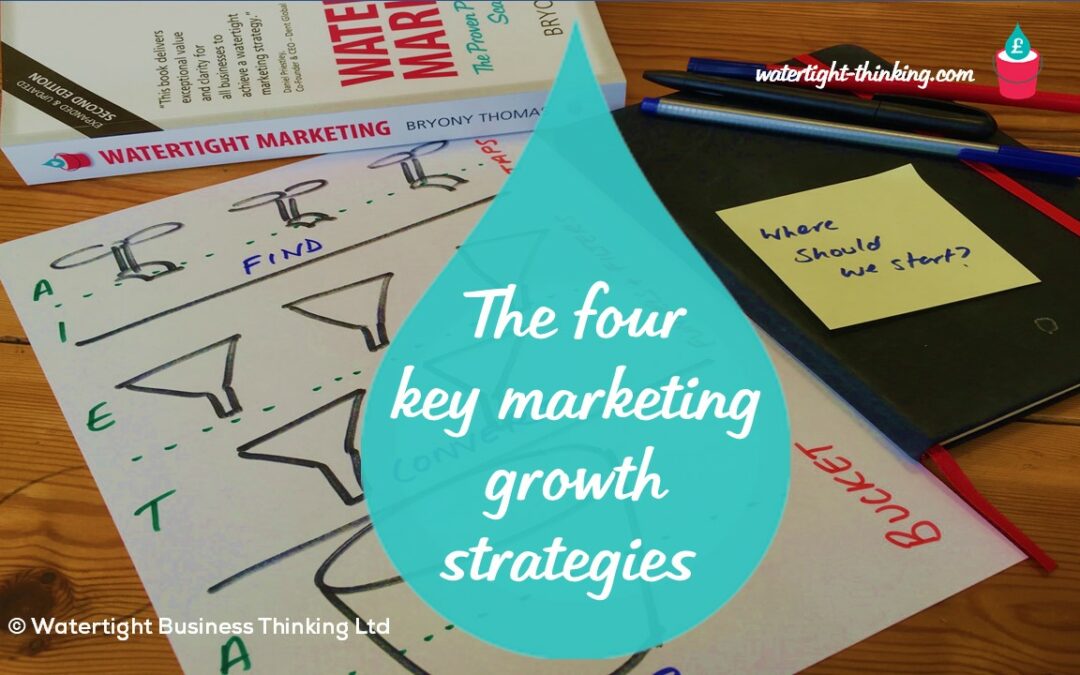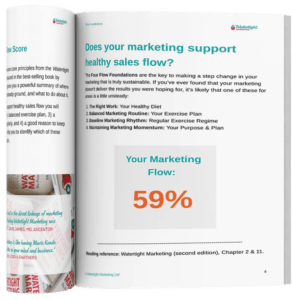Reading Time: 10 Minutes
I remember talking to the partner in a law firm some time ago. He was a bit phased by the business growth targets his managing partner had set for his practice area. It seemed like a big mountain to climb and pretty overwhelming. In our conversation, I suggest he break it down to make it more manageable, starting with existing clients of the firm. In this blog, I’ll look at how to achieve growth by looking at the underpinning marketing strategies and the sequence in which to address them. – Rachael Wheatley | MD, Watertight Business Thinking
It’s safe to say we’re in challenging times. That’s true whether your business is thriving and you’re struggling to keep up with demand and the recruitment implications that has or it’s a bit quieter than normal and you’re looking at what opportunities there might be. Whichever situation you’re in, now is a good time to consider how to focus your time and energies in the months ahead.
Whatever your plans for the short, medium or long term, they will include one or both of the following:
- Keeping relationships with existing clients strong and healthy;
- Building relationships with new clients who don’t yet buy from you.
So, when you’re thinking about growth, this is where it’ll come from. And, you’ll need a different marketing strategy and plan for each route.
Here are the four key marketing strategies that support business growth, in this order. If your plans are fulfilled by the first step, you need go no further. If there’s still a gap between where you are and where you want to get to, go on to the next step. The steps increase in the investment needed in time, marketing planning and activity, money and risk, which is why they’re sequenced in this way.

Step 1: The treasure in your own back yard
The first step is to protect existing business and make sure your clients stay your clients. Technically not growth, it’s really about ensuring your existing business doesn’t walk out of the door because you’re more focused on winning new clients. It sounds obvious, I know, but I’ve seen exactly this happen quite a few times… and important existing clients quietly walk out the door because they’ve been forgotten in the company’s quest for jam tomorrow.
It goes without saying (or does it?!) that keeping existing clients happy is critical, whether your engagement has an end point, you’re on a on-going contract or if you need to re-tender at intervals. This is what I call ‘bankable’ business. Not that you’re taking it for granted, but you have on-going engagements and contracts and a momentum to your business that means you know you’ll have revenue for at least the next few months.
Part of your thinking here, too, is to determine what other products or services you already offer that might be relevant to existing clients. It could be more of the same (they might have a need) or it could be something they’re unaware you provide which could be perfect for a problem they have. The key here is to recognise it’s all about the client, understanding their situation, needs and wants and offering a solution. Working out what’s relevant to that client, what they might value at what point. And then keeping on their radar so that when the time is right, they think of you.
In conversation with a client recently, she mentioned that her firm had recently conducted some research. One key piece of information they gathered was that many of their clients didn’t understand the whole of what they did. They used them for one area – the first one they’d worked with – and just hadn’t been introduced to any other service the firm provided. Clients were making assumptions about the firm’s capabilities, the size of companies they worked with, the sectors they knew about, the experience they had. A meeting with one client they’d worked with for a while surfaced an opportunity for the firm to help that client solve a particularly knotty challenge in an area they hadn’t even realised the firm had deep expertise.
Key tips:
- Identify key clients, valued clients and all others and create a communications and service plan for each group. What tips, information, knowledge, experience can you share with them?
- Assign someone responsible for each of your top 10 clients who will proactively manage, protect and develop relationships with people in these organisations. Keep in contact with them, even if it’s for a chat and catch-up. Talk with them about their plans – set up a meeting now if you haven’t got anything in the diary already.
- Ensure that all staff know the full range of what you do – it’s not a given, especially once you get to a certain size!
Step 2: Like-minded potential clients
What you’re looking for here is more of those focus clients you love to work with. This extends your existing client-base to companies you don’t currently work with, but still the kind of businesses which will motivate your people and align with your vision, values and plan. You might partner with other organisations who have the ear of a similar audience, for instance, or look for other businesses similar to the clients you have, whilst still making sure you’re looking for organisations that would be in the top right of your Purpose/Profit Matrix.
Key tips:
- Revisit your customer characterisation so that you are crystal clear about the type of person and business you want to work with. Share that widely within the company so all teams – customer services, sales and marketing – can be on the look out for potential opportunities. Then put together a top 20 or top 50 list, populated with such companies and relevant contacts. These are the ones to have in your sights and build relationships with.
- Revisit your marketing plan, taking into account changes in the sector, business and buying decision. Use this information to revise offerings, messaging and activities to make sure they reflect your audience’s current situation and challenges.
- Identify specific people in organisations you’d like to work with and find out where they hang out so that you can start engaging with them and inviting them into your world.
Step 3: Developing new products and services
The next step looks at new offerings to your existing market. That includes existing clients as well as the wider sector or audience you serve, many of which will not – yet – work with you (unless of course you have a high market share!). Sometimes product or service development entails re-framing what you do to deliver in a new way. A good example of this would be turning your face-to-face training programme into an online offering. Another route could be creating brand new products or services for existing clients, perhaps precipitated by a conversation with someone you’re working with. Your starting point here is products linked to your area of expertise but a different way of accessing what you sell, for instance an IT services company creating a new IT and risk management audit that could serve as a stand-alone product to promote to prospects as well as part of a client engagement.
Similarly, you might offer a new service to existing clients that is outside your area of expertise. An employment law firm offering HR services would be an example of how to extend what you do that builds on your expertise and knowledge in a complementary way and provides additional value to your clients. To deliver, they’d need to recruit people or partner with a firm offering these services.
An accountancy firm has historically offered end of year accounts and bookkeeping services. They feel they have the knowledge and expertise to offer business advice and outsourced finance director services to their clients. So, they develop the offering, package these services up and talk to existing clients about what they’d like in the package, what they would find useful. This results is a product they can then take to the whole of their client base. To ensure they are credible for these new services, they need to train their accountants to deliver a more consultancy-type service. In addition they research what excellent finance directors do so they can model and benchmark their service against this bar.
Step 4: Taking what you offer to new audiences
The final step involves looking for opportunities for what you sell to audiences who do not currently know you at all. You might work mainly in one sector but realise that another sector has similar challenges you can solve. It will entail some research, chatting to companies in those sectors to get a handle on how to take your services or product to that new audience and adapting either the product/service or the messages you use to engage with them.
It will involve a wholly new thought-through marketing plan, understanding and mapping the customer decision journey, the frustrations they have and the problem you solve. You’ll certainly need to allow a few months or more to gain traction in that market-place since they won’t necessarily know you as an alternative. We find that in this situation you’ll need to allow a minimum of 9-12 months of a consistently delivered plan to see results.
Key tips:
- Create detailed customer characteristics for these new audiences so that you know where to find them and how to approach them.
- Develop a new marketing plan, re-purposing any existing content.
- Identify specific people in organisations in this new segment you’d like to work with and build relationships with them so that they see you and then like what you’re talking about.
For each of these routes to growth there is a different marketing strategy and plan that needs to be mapped out, that works hand in hand with your sales activity. Both come together to ensure you have everything in place to find, win and keep the right clients which will underpin your growth plans.
Find out more about working with us here

Rachael Wheatley
Managing Director, Watertight Thinking
Rachael brings over 30 years’ of marketing experience, with a particular focus on building and developing effective marketing teams that are able to act as a strategic driving force across an organisation. She has worked with Watertight since 2014 as a Master Practitioner and joined the business as MD in 2022.


